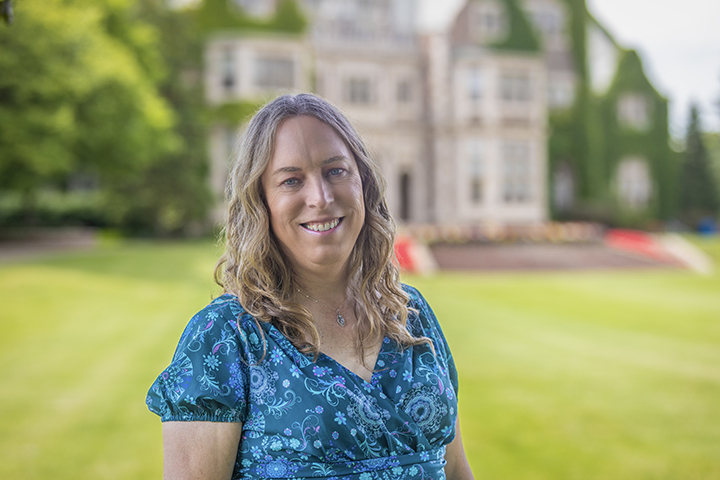
Jamie MaKinster

Jamie G MaKinsterProfessor of Educational Studies, Senior Associate Provost
Joined faculty in 2002
Ph.D. Indiana University (IN)
M.S., Louisiana
B.S., Indiana University of Pennsylvania
Contact Information
Scholarly Interest
Education is most productive and meaningful when it is reflective, collaborative and personally relevant. I strive to help students view themselves as life-long-learners who are able to apply creative problem solving and reflective inquiry in all areas of their lives. Whether teaching a teacher education seminar, independent study, science course or a liberal arts course in education, my role is to support students as they struggle to answer problems, create projects and carry out investigations. I serve as a facilitator, guide and mentor as I provide the tools and resources necessary for their success. Ultimately, I want to help students challenge the assumptions they hold about themselves, contemporary issues and the world.
The products of my scholarship embody my knowledge and perspectives on specific issues in science education and educational technology. The questions driving my scholarship have converged upon the following:
- How do we design and implement highly effective teacher professional development experiences focused on the use of geospatial technologies to teach science?
- How do we design curricular materials that support effective teaching and learning when using geospatial technologies to teach science?
- How do we help secondary science students develop an awareness of and interest in careers that use technology to investigate, address and communicate about environmental issues?
Teaching Experience
Hobart and William Smith Colleges (2002 – Present)
Brown County High School – Nashville, Indiana (Fall 2001)
Indiana University, Bloomington, Indiana (1998 – 2001)
Research
Director and Principal Investigator, Crossing Boundaries Project
Hobart and William Smith Colleges
September, 2008 – September, 2013
Funding: National Science Foundation ($1,498,811) - Innovative Technology Experiences for Students and Teachers
Crossing Boundaries was a collaborative effort between the Hobart and William Smith Colleges and the Cornell Lab of Ornithology. This teacher professional development project ultimately provided middle and high school students with knowledge, skills, and inspiration to use information and communication technologies (ICT) in addressing biodiversity conservation issues in regional and international contexts. The project entailed curriculum development, sustained teacher professional development, and opportunities for students to see scientific and environmental careers in action. Using geospatial technology, secondary students analyzed biodiversity conservation issues in their local environment, Brazil, Mexico, and Kenya.
Director and Principal Investigator, GIT Ahead Project
Hobart and William Smith Colleges
September, 2006 – November, 2010
Funding: National Science Foundation ($899,500) – Advanced Technological Education
The GIT Ahead Project was a collaborative effort among the Finger Lakes Institute at Hobart and William Smith Colleges, Cayuga Community College, Cornell University, and the Institute for the Application of Geospatial Technology. The ultimate goal of this teacher professional development project was to help rural and urban high school students see geospatial technology as pathways to relevant, exciting, and high-demand careers, and to create higher education pathways for students who might not otherwise pursue such goals. GIT Ahead accomplished these goals through teacher professional development, the development of the Internet-based Finger Lakes GIS Explorer software, and a series of classroom and job–focused GIT opportunities for students. Interdisciplinary teams of teachers attended a two-week summer institute that provides training in relevant technologies along with time and support for development of inquiry-based curriculum projects tailored for use in their own classes.
Courses Taught
EDUC083-01: Teaching Elementary Science
EDUC083-02: Teaching Secondary Science
BIOL146: Biology for Elementary Science
EDUC225: Contemporary Concepts in Educational Leadership
EDUC336: Science and Cognition: Ways of Thinking In Science
EDUC346: Technology In Education: From the Chalkboard to Online Communities
EDUC348: Our National Parks
EDUC349: Nature of Science and Scientific Inquiry
EDUC377: Education and Diversity: New Zealand and the United States
EDUC351: Teaching and Learning With Citizen Science
EDUC401: Analysis of Teaching in Secondary Schools
EDUC420: Research in Education
EDUC791: GIS in Schools
EDUC792: Teaching with Emerging Technologies
EDUC801/083: Master's Project Seminar
EDUC820: Graduate Seminar in Education
FSEM141: The Lens of Stand-Up Comedy
Publications
Books
Trautmann, N. & MaKinster, J. (2015). Birds Without Borders: Investigating populations, habitats, and conservation needs of birds in the U.S. and abroad. Dallas, TX: Carte Diem Press.
MaKinster, J.G., Trautmann, N. & Barnett, G. (2014). Teaching science and investigating environmental issues with geospatial technology: Designing effective professional development for teachers. Dordrecht, Netherlands: Springer. (Edited Volume)
Crawford, A., Saul, E. W., Mathews, S., and MaKinster, J. G. (2005). Teaching and learning strategies for the thinking classroom. New York: IDEA Press.
Temple, C., & MaKinster, J. (2005). Intervening for literacy: A primer for volunteer tutors in early childhood classrooms. New York: Pearson Publishing.
Selected Research Articles and Book Chapters
MaKinster, J., Trautmann, N., Burch, C. & Watkins, M. (2015). Where the birds live: Using web-based maps for scientific inquiry into bird habitats and migration patterns. The Science Teacher, Dec 2015: 42-49.
Trautmann, N. & MaKinster, J. (2014). Scientists at work: Online multimedia vignettes enable students to experience the lives of working conservation scientists. The Science Teacher, Oct 2014: 39-45.
MaKinster, J. & Trautmann, N. (2014). Introduction. In (Eds.) J.G. MaKinster, N.M. Trautmann, & G.M. Barnett. Teaching Science and Investigating Environmental Issues with Geospatial Technology: Designing Effective Professional Development for Teachers. Dordrecht, Netherlands: Springer.
MaKinster, J. & Trautmann, N. (2014). The nature and design of professional development for using geospatial technologies to teach science. In (Eds.) J.G. MaKinster, N.M. Trautmann, & G.M. Barnett. Teaching Science and Investigating Environmental Issues with Geospatial Technology: Designing Effective Professional Development for Teachers. Dordrecht, Netherlands: Springer.
MaKinster, J. & Trautmann, N. (2014). The nature of teacher knowledge necessary for the effective use of geospatial technologies to teach science. In (Eds.) J.G. MaKinster, N.M. Trautmann, & G.M. Barnett. Teaching Science and Investigating Environmental Issues with Geospatial Technology: Designing Effective Professional Development for Teachers. Dordrecht, Netherlands: Springer.
MaKinster, J. & Trautmann, N. (2014). Understanding the use of geospatial technologies to teach science: TPACK as a lens for effective teaching. In (Eds.) J.G. MaKinster, N.M. Trautmann, & G.M. Barnett. Teaching Science and Investigating Environmental Issues with Geospatial Technology: Designing Effective Professional Development for Teachers. Dordrecht, Netherlands: Springer.
Trautmann, N., & MaKinster, J. (2014). The GIT Ahead Project: Meeting Teachers Where They Are and Helping Them Integrate Geospatial Technology Into Their Curriculum. In (Eds.) J.G. MaKinster, N.M. Trautmann, & G.M. Barnett. Teaching Science and Investigating Environmental Issues with Geospatial Technology: Designing Effective Professional Development for Teachers. Dordrecht, Netherlands: Springer.
Trautmann, N. MaKinster, J. & Batek, M. (2013). What lives where and why? Understanding biodiversity through geospatial exploration. American Biology Teacher.
Barnett, M., MaKinster, J., Trautmann, N., Vaughn, M.H. & Mark S. (2013). Geospatial technologies: The present and future roles of emerging technologies in environmental education. In B. Stevenson, M. Brody, J. Dillon and A.E.J. Wals (Eds.), International Handbook of Research on Environmental Education. New York: Routledge.
Wilson, C., Trautmann, N., MaKinster, J., & Barker, B. (2011). Science pipes: A world of data at your fingertips. The Science Teacher, Oct 2010: 34-39.
MaKinster, J.G. (2010). Unraveling the sociological, political and epistemological dimensions of science through a role play simulation on Bt genes in corn. In (Eds.) Bodzin, A., Shiner Klein, B., Weaver, S. (Eds.) The Inclusion of Environmental Education in Science Teacher Education. Dordrecht, Netherlands: Springer.
Trautmann, N., & MaKinster, J. (2010). Flexibly adaptive professional development in support of teaching science with geospatial technology. Journal of Science Teacher Education, 21(3): 351-370.
Wilson, C., Murphy, J., Trautmann, N. & MaKinster, J. (2009). Local to global: A bird’s eye view of changing landscapes. American Biology Teacher, 71(7): 412-417.
Meyer, L., Sherman, L., & MaKinster, J. (2006). The effects of global education on third graders’ cultural sensitivity: Understanding the Japan BRIDGE Project. Theory and Research in Social Education, 34(3): 347-369.
MaKinster, J. G., Barab, S. A., Harwood, W. S., Andersen, H. O. (2006). The effect of social context on the reflective practice of pre-service science teachers: Incorporating a web-supported community of teachers. Journal of Technology and Teacher Education, 14(3), 543-579.
Hansen, J. A., Barnett, M., MaKinster, J. G., and Keating, T. (2004). The impact of 3-D computational modeling on student understanding of astronomical concepts: A qualitative analysis. International Journal of Science Education, 26(13), 1555 – 1575.
Barab, S., MaKinster, J., & Scheckler, R. (2004). Designing system dualities: Characterizing online community. In Designing for Virtual Communities in the Service of Learning. (Eds.) S. Barab, R. Kling, & J. Gray. Cambridge: Cambridge University Press.
Squire K., MaKinster J., Barnett, M., Luehmann, A. L., & Barab S. A. (2003). Designed curriculum and local culture: Acknowledging the primacy of classroom culture. Science Education, 87(4): 468-489.
PROFESSIONAL AFFILIATIONS
National Association for Research in Science Teaching
National Association of Biology Teachers
American Educational Research Association
